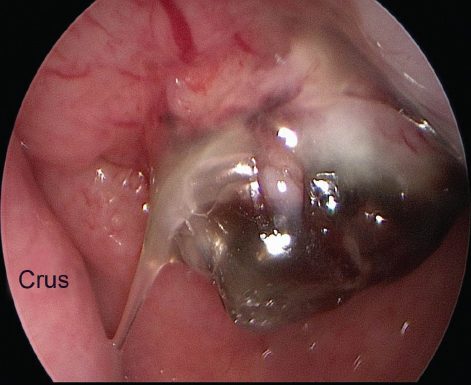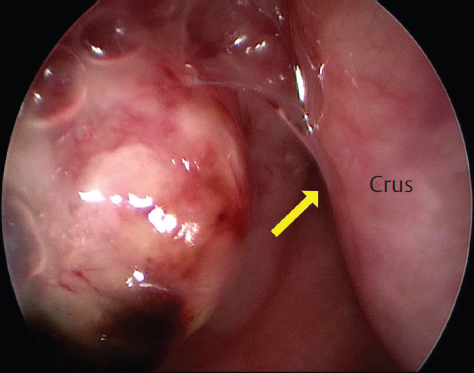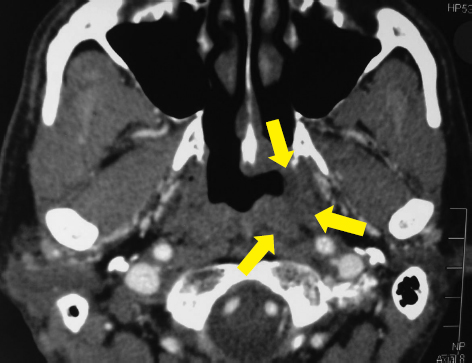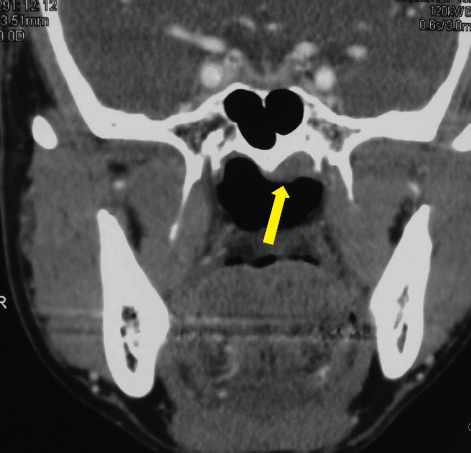34 Nasopharyngeal Carcinoma Nasopharyngeal carcinoma (NPC) is an uncommon pathology in the West but endemic in Southern China, South Asia, and Sub-Saharan Africa. NPC is highly aggressive; it has a propensity to invade surrounding tissues such as the para-nasal sinuses and skull base and tends to spread to cervical lymph nodes. The undifferentiated type of NPC is the predominant histological type in endemic regions, and it has a high propensity for distant metastases. Radiotherapy with or without chemotherapy is the primary treatment modality for newly diagnosed NPC, whereas surgery is usually reserved for management of residual or recurrent disease. In patients with locoregional recurrence, salvage surgery should be considered if technically feasible. Patients who are not candidates for surgery can receive reirradiation. In patients with advanced recurrence and distant metastases, palliative chemotherapy can often achieve durable control of symptoms and disease. Less frequently, long-term survivors are seen after aggressive chemotherapy and targeted therapy. The symptoms of NPC are related to the location of the tumor in the nasopharynx, extension to surrounding structures, and regional metastasis. Unilateral nasal obstruction with blood-stained nasal discharge is the most common nasal symptom. Hearing loss and tinnitus are related to the tumor affecting eustachian tube function and resulting in serous otitis media. Patients with advanced disease may present with cranial nerve palsies that are the result of superior extension of the tumor to the skull base. Cranial nerves III, IV, and VI are frequently involved. The commonest mode of presentation is a painless upper neck unilateral mass, and this is a metastatic cervical lymph node. Symptoms of early stage disease are usually nonspecific and minor, thus frequently ignored by the patient and even the physician, resulting in most patients presenting at the late stage of disease. Examination of the nasopharynx can be performed under local anesthesia with either a rigid or a flexible endoscope. The rigid 0- or 30-degree Hopkins rod endoscopes provide an excellent view of the nasopharynx (Figs. 34.1 and 34.2). When a suspicious lesion is seen, a biopsy can be taken with a pair of forceps inserted along the endoscope. The use of flexible fiberoptic endoscopes allows a more thorough examination of the whole nasopharynx; the tip of the endoscope can be manipulated behind the nasal septum to see the entire nasopharynx with the scope inserted through one nasal cavity. Figure 34.1 Endoscopic view of a nasopharyngeal carcinoma situated at the posterior wall of the nasopharynx with the 0-degree endoscope inserted through the right nasal cavity. The medial crus of the right eustachian tube are marked. Figure 34.2 Endoscopic view of the same nasopharyngeal carcinoma situated at the posterior wall of the nasopharynx with the 0-degree endoscope inserted through the left nasal cavity. The medial crus of the left eustachian tube are marked. The left fossa of Rosenmüller is shown (arrow). As Epstein-Barr virus (EBV) has a strong association with NPC, the level of antibodies against EBV is related to the stage of the tumor, which is proportional to the tumor burden. The antibodies (IgA) for the viral capsid antigen and early antigen have been used widely to screen for early NPC. In recent years, circulating free EBV DNA can be detected by polymerase chain reaction assay in patients suffering from NPC; this has been shown to be more accurate than measuring the antibody titers against the various EBV antigens.1 Cross-sectional imaging contributes to the assessment of the tumor. This includes the involvement of the musculature of the nasopharyngeal wall and the erosion of bone at skull base. Computed tomography (CT) is useful in detecting skull base bone erosion and tumor extension into the paranasopharyngeal space. These findings provide information for accurate staging of this malignancy (Figs. 34.3 and 34.4). When a biopsy of an enlarged retropharyngeal node is required and it cannot be visualized with an endoscope, then the CT navigation system is applicable. Under the guidance of the navigation system, the surgeon can insert forceps through the wall of the nasopharynx accurately into the retropharyngeal node for the biopsy. Magnetic resonance imaging (MRI) cannot demonstrate subtle bone erosion, but it has better tissue specificity and distinguishes tumor from inflammation. It also has multiplanar capabilities and is useful in evaluating the extent of cervical nodal metastases; this includes the retropharyngeal nodes of Rouviere. Cross-sectional imaging modalities, such as CT and MRI, complement each other and display the extent of the primary tumor precisely. Figure 34.4 Coronal computed tomography showing the same recurrent nasopharyngeal carcinoma (arrow) attached to the skull base. Positron emission tomography can reveal NPC at the primary site and the metastatic lymph nodes. However, it does not improve the diagnostic rate or affect the staging.2 Although it can detect distant metastasis, it has been shown to be less sensitive than whole body MRI. Its real value is the ability to detect residual and recurrent tumors in the nasopharynx.3 Radiotherapy is the primary treatment modality for locoregionally confined NPC. The outcome of patients after radio-therapy for NPC has improved significantly from a 5-year survival rate of 25% in the 1950s,4 to 50% in the 1970 to 1980s,5 and to 75% in the 1990s.6 This improved outcome is because of multiple factors including earlier stage disease at presentation, improved imaging technique, use of conformal radiotherapy technique, and combined chemoradiotherapy. In designing radiotherapy for NPC, a large target volume is needed to cover the nasopharynx and potential sites of spread, which includes the paranasopharyngeal space, oropharynx, base of the skull, sphenoid sinus, posterior ethmoid sinus, and posterior half of maxillary antrum. Extension of treatment field to cover cavernous sinus and cranial fossa may be needed in advanced disease. Cervical nodal irradiation is mandatory even in node-negative patients because of the high incidence of neck relapse in the absence of prophylactic nodal irradiation.7 A dose of 65 to 70 Gy is normally given to the primary tumor, 65 to 70 Gy to the involved neck nodes, and 50 to 60 Gy to node-negative neck. In recent years, intensity-modulated radiotherapy (IMRT) has become the preferred technique for the treatment of NPC. IMRT is a radiation technique that allows the delivery of highly conformed dose distribution to the target and critical structures through optimization of intensity of multiple beams. The treatment design is based on the computer algorithm to calculate the best result that matches the user-defined parameters in a process called inverse planning. The advantages of IMRT include the ability to deliver highly conformal radiotherapy to irregular target, the ability to treat primary and regional lymphatic in one volume, and the ability to deliver simultaneous integrated boost in the same setting. IMRT has already achieved excellent local control rates for newly diagnosed NPC, with a reported local control rate of 92 to 97% at 3 to 4 years.8,9 Apart from improvement of tumor control, IMRT also reduces the risk of late complications such as xerostomia in early stage disease.10 Combining chemotherapy and radiotherapy has been used increasingly for the treatment of NPC, especially for those with advanced disease. The high incidence of distant metastases, despite successful locoregional control with radiotherapy alone, helps support this strategy. NPC has a high response rate to most chemotherapeutic agents, and these agents also have a radiosensitizing effect when used in combination with radiotherapy. Many randomized trials have been conducted to explore the benefits of combined chemoradiotherapy in NPC. Four randomized phase III studies comparing induction chemotherapy followed by radiotherapy versus radiotherapy alone in NPC have been reported.11–14 None of these studies have demonstrated survival benefits when adding chemotherapy to radiotherapy. However, two of these studies were recently updated and the data pooled for analysis; a significant improvement in disease-free survival in the chemotherapy arm was observed, but the overall survival was not improved.15 Only two adjuvant chemotherapy phase III studies have been reported, and both showed no survival benefits.16,17 These studies showed that induction chemotherapy alone has a limited role in NPC, whereas the role of adjuvant chemo-therapy remains undefined. In recent years, concurrent chemoradiotherapy has emerged as the treatment of choice for locoregionally advanced NPC. This is largely because of the positive findings of the Intergroup 0099 trial. This was the first randomized trial to demonstrate survival benefit with the use of chemotherapy in this disease.18 The Intergroup trial employed both concurrent and adjuvant chemotherapy in the study arm and reported an absolute survival improvement of 31% at 3 years. Subsequent randomized trials conducted in endemic regions have largely confirmed the benefits of concurrent chemoradiotherapy for advanced NPC, although different regimens and schedules were used in these studies.19–22 Only one study employed the same chemotherapy regimens used in the Intergroup study. The final report from that study showed no survival benefits, although there was an improvement in progression-free survival.23 Nevertheless, current evidence indicates that concurrent chemoradiotherapy has a major role in advanced stage NPC, but the optimal regimen/schedule remains to be defined. On the basis of current evidence, the doctors should advise chemoradiotherapy to all patients with nodal disease or T3 to T4 disease, whereas radiotherapy alone should be reserved for those with T1 to T2 N0 disease. Despite the use of concurrent chemoradiation with improved outcomes, there are still patients who have persistent or recurrent locoregional tumors. The incidence of local residual or recurrent was around 8.3%24 and regional recurrences in the cervical nodes was around 4.7%.24 Endoscopic examination of the nasopharynx with biopsy of suspicious lesions is the standard procedure to confirm the presence of residual or recurrent disease. Elevated copies of EBV DNA in blood and imaging studies such as CT and MRI are useful adjunct tests to raise the suspicion of possible persistent or recurrent disease. This is particularly so with increasing number of EBV copies and progressive enlarging masses. Positron emission tomography scan has also been shown to be better than the conventional imaging studies in the diagnosis of residual disease.25 Residual or recurrent tumor in the cervical lymph nodes after radiotherapy is however more difficult to confirm. Fine needle aspiration is not helpful because only clusters of tumor cells are present in some of the pathological lymph nodes, and it is difficult to get a cytological diagnosis.26 The increasing size of the lymph nodes on clinical examination or sequential imaging is worrying. The definitive diagnosis still depends on histological examination and occasionally this becomes available only after salvage surgery. For localized disease in the nasopharynx or the neck, salvage therapy should be offered if possible. Survival after salvage therapy for extensive disease remains poor, but it is still higher than that in patients receiving only supportive treatment.27 With a second course of external radiotherapy to treat cervical lymph node metastases, the 5-year actuarial control rate of local nodal disease was 51% and the overall 5-year survival rate was 19.7%.28 Some report that the excision of these lymph nodes followed by a second course of radiotherapy was not promising,29 and the second course of radiotherapy was associated with significant morbidity. The optimal management of localized metastasis in the neck lymph nodes depends on the pathologic behavior of the tumor. Radical neck dissection is recommended as the salvage treatment of choice for cervical nodal metastasis after radiotherapy. Serial sectioning study of radical neck dissection specimens revealed there were more tumor-bearing lymph nodes than clinically evident, and 46% of these nodes exhibited extracapsular spread.30 With radical neck dissection as salvage surgery, the 5-year rate of control of disease in the neck was 66%, and the 5-year actuarial survival for this group of patients was 38%.31 A recent review showed that neck nodes in level I were infrequently affected in these patients, and that a less extensive neck dissection sparing level I might be applicable in patients.32 When the residual or recurrent cervical lymph node has extensive involvement, such as affecting the floor of the neck or the overlying skin, then brachytherapy should be applied in addition to the radical neck dissection for salvage. The skin over the metastatic cervical node is removed with the specimen, and hollow nylon tubes are positioned over the operative site for after loading brachytherapy with iridium wires. The cutaneous defect in the neck is covered with either a deltopectoral flap or a pectoralis major myocutaneous flap. With this form of therapy, local tumor control rate of more than 60% has been reported.33
Symptoms and Signs
Diagnosis
Clinical Examination
Serology
Imaging Studies
Treatment
Radiotherapy
Combined Chemoradiotherapy
Residual or Recurrent Disease
Incidence
Disease in the Cervical Lymph Node
Disease in the Nasopharynx
Stay updated, free articles. Join our Telegram channel

Full access? Get Clinical Tree






